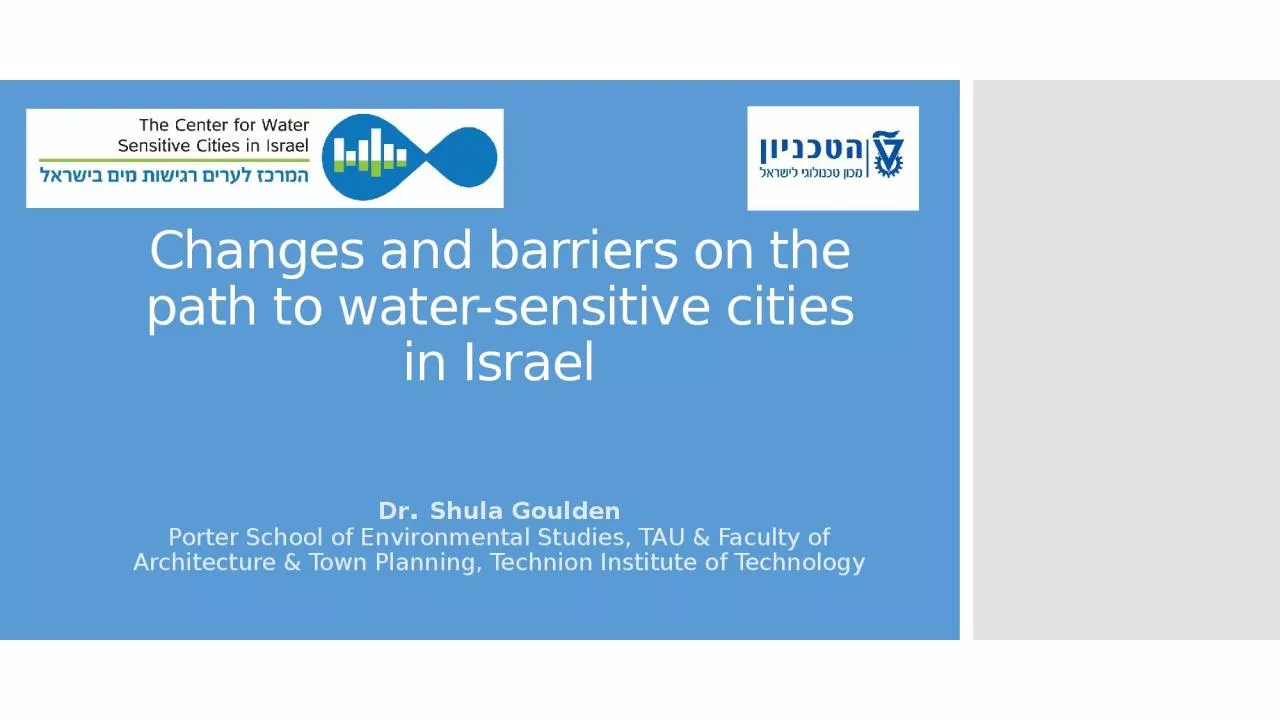

Dr Shula Goulden Porter School of Environmental Studies TAU amp Faculty of Architecture amp Town Planning Technion Institute of Technology Subproject P41 Understanding WaterSensitive Urban Design WSUD in the Israeli Context ID: 930305
Download Presentation The PPT/PDF document "Changes and barriers on the path to wate..." is the property of its rightful owner. Permission is granted to download and print the materials on this web site for personal, non-commercial use only, and to display it on your personal computer provided you do not modify the materials and that you retain all copyright notices contained in the materials. By downloading content from our website, you accept the terms of this agreement.
Slide1
Changes and barriers on the path to water-sensitive cities in Israel
Dr. Shula GouldenPorter School of Environmental Studies, TAU & Faculty of Architecture & Town Planning, Technion Institute of Technology
Slide2Sub-project P4.1:Understanding Water-Sensitive Urban Design (WSUD) in the Israeli Context:
Policy aspects Research team: Prof. Tal Alon Mozes, Dr. Michelle Portman, Prof. Naomi Carmon, Dr. Shula Goulden, Arch. Elissa Rosenberg, Nadav Shapira
Goal: Evaluation of WSUD policies and practices in Israel1. Review and analyse the implementation of WSUD practices within the Israeli planning context2. Produce recommendations for the improvement of policies that can lead to greater adoption of stormwater BMPs, including impediments and supports
Slide3Elements of “sustainable stormwater management”
Conventional drainage
Sustainable stormwater managementAttitudesControl and remove stormwaterHandle extreme eventsResource for humans and
nature
Manage day-to-day and extreme events
Goals
Avoid flooding,
pollution, erosion
Multiple goals (water;
ecology; social; economic)
Measures
Rapid removal in urban areas with constructed infrastructure
Slowing
runoff, conveyance, detention, infiltration, biological and mechanical treatment; floodplain management
Professional
roles
Drainage engineers design infrastructure
Professional cooperation from
early stages in order to influence design
Slide4How
do we analyse supports and barriers to sustainable stormwater management? Many factors play a part:
Technical knowledge
Professional adaptation
Changes in regulation and plans
Water management goals
Civil society impact
Legal responsibility and jurisdictions
Sustainability discourse
Availability of technologies
technical
social
Slide5The study
Analysis of changes across three institutional pillars (based on Ferguson et al, 2013)CULTURAL-COGNITIVE awareness, knowledge, goals
NORMATIVE professional norms, trainingREGULATIVE laws, plans, responsibility
From 1990 to present day
A change to sustainable
storwmater
management requires all three.
Slide6Findings in detail
Slide7FINDINGS
CULTURAL-COGNITIVE CHANGES
2010
2000
Academic research points to need for groundwater infiltration and potential of water-sensitive planning
Government decision on sustainable development strategy (2003)
Stormwater
management (vs. drainage) increasingly accepted in drainage authorities
Increasing awareness of urban sustainability in municipalities, NGOs, public
Slide8FINDINGS
NORMATIVE CHANGES
2010
2000
End 90s – stormwater management workshop for drainage authorities and other professionals
Guide on run-off conserving construction
מרדיך תכנון
ובנייה משמרת נגר
(2004)
– implementation?
Increasing norm of professional cooperation and
stormwater
considerations in all stages of planning
– niche?
Emphasis on infiltration in practice
– other goals?
Slide9FINDINGS
REGULATORY CHANGES
2010
2000
1957 Drainage and Storm Protection Law still in force
Stormwater planning guidelines – Tel Aviv and Central District Planning Committees
National Outline Plan 34/b/4 – infiltration requirements (2007)
– professional capacity?
Slide10ConclusionsSocio-institutional changes have occurred, mostly in awareness
and discourse ( “hazard resource”), some professional standards and statutory plans. However, changes support a focus on an infiltration/groundwater replenishment
paradigm (based on earlier water management concerns). Water resource management has changed (desalination, high rates of wastewater treatment) alongside greater environmental awarenessMulti-functional, multi-disciplinary approaches restricted to certain case studies.
Slide11Barriers and Recommendations
BARRIERSRECOMMENDATIONS
Focus on infiltrationDevelop consensus on stormwater benefits at different geographical scales
Greater
public awareness and inclusion of SWM as key factor in urban sustainability programs
Broaden statutory plans (
תמ"א
) and other guidelines with emphasis on multiple benefits
Limited professional
training and emphasis on cooperation.
Widespread planning changes require professional expertise
Professional training
on planning and engineering approaches
Emphasis on role of professionals in change
Drainage
Law and outdated regulation
Update to law, to anchor the change in discourseEnhanced cooperation between national, regional (drainage authorities)
and local authorities Water regime: lack of responsibility and incentive for local authorities to manage stormwater
Incentives for local authorities; raised public awareness
Slide12Thank you for listening shulag@gmail.com